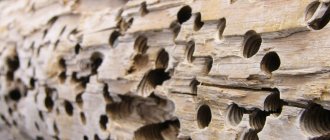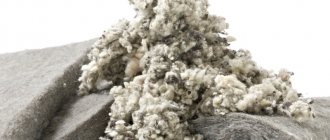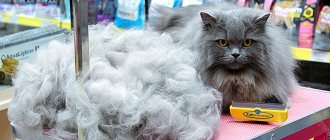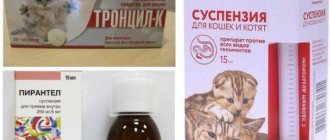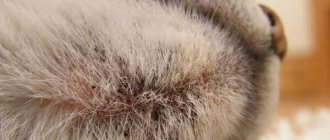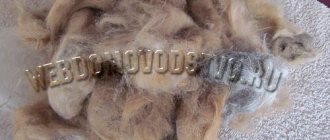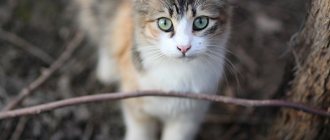Sheep wool is widely used for the production of clothing, shoes, carpets, and blankets. Such material is always highly valued on the market, as a result of which the number of breeders involved in sheep breeding is constantly growing. Today, the largest number of farms raising such animals are concentrated in Australia, China, Great Britain, and Turkey. But it is worth talking about the value of raw materials only if the processing of sheep wool is properly organized. And this direction, if properly organized, can become a completely profitable business, promising considerable benefits to the breeder.
Sheepskin
Features of business organization
Organizing a successful enterprise for raising sheep and processing wool involves a number of important nuances that are worth paying attention to. Only in this case can we talk about significant benefits.
First of all, the breeder must determine for what purpose he plans to raise sheep. The production of wool can become either the main specialization of the farm or a secondary one. In the second case, the main direction will be meat, milk, lambs for other farms or smushki. It depends on what specific breed of livestock to breed.
But it is irrational to determine the target direction of an enterprise only on the basis of one’s own preferences. You should definitely take into account:
- Demand for products in the region and throughout the country. If there are meat processing plants or dairy production facilities in the immediate vicinity of the farm, then it may be more profitable to consider wool as a secondary product. If there are massive textile industries, it will be more profitable to focus specifically on wool processing.
- State support. When opening a large enterprise, you should check with the local administration about the availability of existing government projects in this direction. Such programs involve subsidies, assistance in marketing products for export, and provision of areas for grazing.
The last point is especially important. Without the presence of vast pastures available for exploitation by private owners, it is not possible to organize a large sheep farm.
Sheep grazing
You should also take into account the climate and topography of the region. This moment allows you to correctly determine the direction of wool production and decide on the breed suitable for it. The main directions in this regard include:
- Coarse-haired. As the name suggests, the main goal of such sheep farming is to obtain coarse wool. It is suitable for breeds that are accustomed to desert and semi-desert regions.
- Semi-coarse-haired. Semi-rough raw materials are obtained from sheep, which are bred in mountainous areas. Not all breeds are suitable for breeding in such conditions.
- Fine wool. This direction of sheep breeding involves the cultivation of varieties bred in the steppes and deserts.
- Semi-fine fleece. This direction is implemented in regions with vast rich pastures and a humid climate. At the same time, appropriate types of livestock are selected.
For most regions of Russia with their characteristic climate, the most rational direction of wool production is semi-fine wool.
Modern market trends
All types of sheep wool are in demand on the market, while sheep breeding in Russia is poorly developed. There are usually no problems with selling goods from sheep farms. Selling finished products is always more profitable than selling raw materials, so wool processing production would be useful.
Own raw materials will increase the profitability of the mini-plant. Before creating a business, it is important to make sure that the final product is in demand, is in demand on the market, and its price will cover the costs. The plant capacity must correspond to the amount of raw materials (outsourced purchases).
When starting a wool processing business, you need to find suppliers of raw materials and buyers of finished products. Such plants quickly pay for themselves in sheep-raising areas where farmers sell their wool. Your own sheep farm will provide production with constant raw materials and the possibility of additional income from meat.
Types of wool raw materials
After studying the general points and available resources, you should also pay attention to the existing types of wool. Each of them requires its own texture and quality, which ultimately affects the cost of raw materials. The main types of wool products include:
- Fine wool. Such raw materials are obtained by shearing fine-wool sheep. The basis of this fabric consists mainly of downy hairs, which provides it with special softness. The average length of fine wool does not exceed 9 cm. In the process of processing raw products, it is possible to obtain no more than 50%. This material is highly valued in textile production.
- Semi-thin. There is significantly less fluff in this composition, and the main part is occupied by transitional hair. The raw materials are obtained from semi-fine fleece sheep. The value of such material is already lower. It is used to produce a separate type of felt.
- Semi-rough. In addition to down and intermediate hair, the wool also includes a thin awn. The length of the fibers ranges from 8 to 19 cm. It is obtained from semi-coarse-haired animals and hybrids of coarse-haired and fine-wooled varieties. Such raw materials are used in the production of coarse carpets, shoes, felt, which is designed for installation in cars.
- Coarse wool. Assumes the presence of all types of hair fibers. Depending on the length, it is divided into spring and autumn. Such products are obtained exclusively from coarse-haired breeds of cattle. It is used for the production of technical felt and individual parts of shoes.
Also, all wool obtained from sheep can be divided into:
- Homogeneous. It contains one specific type of animal hair. It consists exclusively of down, transitional hair or awn.
- Heterogeneous. The texture of such a fabric suggests the presence of several types of fibers. Heterogeneous raw materials are valued lower than homogeneous ones.
Reference. Often, to improve the quality of semi-coarse, coarse and semi-fine material, crossing the corresponding breed of sheep with representatives of the fine-fleece direction is used. In most cases, this can significantly improve the quality of the hair of the resulting offspring.
Properties and uses
This illustration of wool threads under a microscope shows us why wool is special. The surface is a series of overlapping protein scales. On an animal, this allows foreign substances to escape from the comb. In a strand of yarn, it allows the fibers to cling to each other. This is the key to the power of wool.
The surface of the wool repels water. Because moisture does not remain on the surface, wool fabrics tend to feel dry and comfortable even in wet weather. The inner core absorbs moisture - so much so that wool can absorb almost twice its weight in water and still feel quite dry. This absorbency also gives wool a natural resistance to wrinkles. Absorbed moisture also traps static electricity. And because of its internal moisture, wool is naturally fire resistant.
Read about: artificial regenerated protein fibers.
Wool today is valued for its beauty and durability. It is still the top choice for high-quality business suits, warm sweaters and luxury rugs.
Breed selection
Having decided on the main direction of the farm’s work, you can move on to choosing specific breeds of small cattle. Breeders obtain the highest quality raw materials when breeding semi-fine-fleece long-wool sheep. A characteristic feature of such products is uniform wool with a unique shine, which is highly valued in textile production. The most popular breeds in this regard include:
Lincoln sheep breed
- Russian longhair. The fur of such animals is uniform, soft and shiny. The average annual clip from one ram is 6 kg. The uterus produces up to 4.8 kg of raw materials per year. The breed line was developed by crossing local varieties of sheep with animals of the Lincoln breed.
- Lincolnskaya. The wool of this breed is especially highly valued. It is distinguished by intense shine, special strength and length of hair fibers. The average yield of pure material is 55%. Priming is carried out twice a year. The average annual weight of wool from one ram reaches 8-10 kg. About 5.5 kg is shorn from a sheep. Lincolns are quite demanding when it comes to living conditions.
To obtain second-class raw materials, the following types of animals are bred:
- Corridel. These animals have coats that are completely white or with shades of beige. It is highly valued by buyers. The animals themselves are hardy and suitable for year-round keeping on pastures.
- Romney march. Hair also suggests high value. Of the initial cutting, about 60-65% remains after processing. The average volume of wool from one ram is 8 kg.
- Kuibyshevskaya. This is a native Russian breed. It also implies high levels of productivity. Up to 5.5 kg of wool is sheared from one male per year. During processing, about 56% of the original volume is retained. Sheep can withstand high temperatures.
- Tien Shan. This variety brings the owner up to 10 kg of crossbred wool per year. The length of its hairs is 12-12.5 cm. The yield after processing is 68-70%.
When should you get a haircut?
Shearing a ram or sheep is an easy procedure. It is just as easy for animals, if you choose the right time. The main points you should know to properly trim cattle at home are:
Sheep and rams with uniform wool are sheared by the farmer annually in the spring.
Animals should not be cut more than once a year. Rams and sheep with mixed wool types are trimmed twice a year: it is best to do this during spring and autumn. For some coarse-haired breeds, the procedure can be carried out 3 times a year. For lambs, the procedure period should begin when they reach 5 months. If newborns have thin or semi-thin fur, you should not touch it until it reaches 4-5 cm in length. Regardless of the region where the farmer lives and the climate zone, the same rule applies: cut hair during a long warm period. The previous point cannot be overdone, so it is important to remember that in too hot climates the animal will become ill from excess heat. And if you trim the fur a little earlier than the onset of warm weather, the animal may get sick, because the function of fur on the animal’s body is to regulate thermal processes. A farmer must always be ready
For coarse-haired individuals, it is important to seize the moment, otherwise molting will begin with the onset of warm weather. The timing of shearing should exclude the period of transformation of wool into fleece, for which the most accurate days are calculated.
It is a mistake to believe that you need to shear the wool from a sheep several times a year. It all depends on the climatic conditions of living and growing this breed. For some individuals, the period of shearing occurs three times a year, and for some - once, and even then with difficulty. The most optimal period for all breeds is the spring period, which includes all summer months: from the beginning of March to the end of May.
Primary processing of wool
Immediately after shearing the sheep, the owner of the farm receives raw material. This is unwashed wool. There are two ways to implement it:
- Delivery of the entire volume of raw materials to procurement enterprises. In such institutions, wool is washed and processed, and in processed form it is sent to textile factories. The cost of raw materials is quite low.
- Independent processing of raw materials. In this case, the material is processed on the farm and sold to factories without an intermediary. The benefits are much higher.
Of course, the second option requires additional purchase of equipment and the formation of a production line. The specific configuration of such a line will depend on the wishes and capabilities of the owner. But the minimum equipment it includes includes specialized washing machines and dryers. Today there are several varieties of such technology. The main difference is performance. Its value can range from 14 to 400 kg of raw materials per hour.
Sheep wool processing
The washing machine washes the fibers free of any particles of dust and dirt. The drying machine removes excess moisture from the resulting fraction. For a small start-up farm, in this regard, a line with a productivity of up to 15 kg/h will be sufficient.
Preparation for dressing sheep skin
Before dressing a sheep's skin, it must be properly removed. In order not to compromise the integrity of the sheepskin, this procedure must be performed carefully, following the following sequence of actions:
- Make a small cut in the neck area, and then run the knife down to the root of the tail along the entire abdomen.
- Make circular cuts along the carpal joints of the front legs. On the hind legs, make the same cuts near the hock joints.
- Remove the skin from the carcass carefully, making small cuts along its inner surface. The integrity of the sheepskin must not be compromised.
- Remove all debris from the surface of the skin. Carefully scrape off any remaining tendons and meat from the flesh.
- Fold the sheepskin in half so that the inner side (not the front side of the skin) is inside. Leave it in a cool room for 2 hours to cool.
Did you know? Felt is made from sheep wool, which absorbs noise well and is used in construction and aircraft manufacturing.
Tools and equipment
To quickly and efficiently repair sheep skins, you will need special equipment. On large livestock farms, additional equipment is used that allows for high-quality cleaning and drying of sheepskin.
A list of the main tools and devices used during dressing is presented below:
- A sharp knife is used to separate the sheepskin from the body of the sheep.
- A wooden block with a perfectly smooth and even surface - intended for spreading skins on it.
- A tray for collecting cut sections of flesh.
- Mezdryak is a special knife with a curved, smooth or serrated blade and two handles. It is intended for cutting off the remaining meat and fat on the underside of the sheepskin, and on large farms it is replaced by a fleshing machine.
- Capacious containers for soaking hides in solutions at different stages of dressing.
- Centrifuge - designed for accelerated spinning of wet sheepskins, which facilitates their rapid drying.
Raw materials
The technology for making sheepskin depends on the type of raw materials used and is selected taking into account the purposes for which the finished product will be used. At the same time, the quality of the tanned skin depends on how carefully and accurately its processing was carried out, and the best result can only be achieved under production conditions.
There are several types of raw materials for producing sheepskin:
- Fur - its source is fine-fleece and semi-fine-fleece sheep, which have thick and fluffy fur with a uniform structure. Such skins contain a high amount of fat and are intended for making things that are worn with the fur facing out. Dressing sheepskin is the most labor-intensive and consists of the largest number of stages.
- Fur - such skins are removed from coarse-wool sheep, under the skin of which there is a relatively small layer of fat. The resulting sheepskins are used to make durable products that are resistant to moisture. In order for the finished material to acquire such characteristics, during dressing it is necessary to pay special attention to the processing of the core.
- Tanning - due to the quality of the fur, such skins are not suitable for the production of fur clothing, so suede and leather products are made from them.
Processing tools
Washing and drying wool is just one of the stages of a sheep farm. But, before they can be carried out, it is necessary to cut off the raw material from the living creatures. You will also need to remove unnecessary hair from the fraction and organize the remaining material. All this is done using the appropriate tool. The list of essentials includes:
- electric sheep clipper or special scissors;
- carder;
- comb used for combing wool;
- spinning wheel;
- spindle.
It is also advisable to purchase a loom for the farm in advance. In this case, the breeder will also have the opportunity to try his hand at independently producing textiles. Handmade textiles are also highly valued in the market.
The type of tool should also be selected based on financial capabilities and production volumes. In a small enterprise, staff can handle this with hand tools. For larger objects, it is necessary to purchase an automatic carder, a spinning wheel and a flock shearing machine.
Making things
Forward-thinking owners complement small factories for processing raw materials with workshops for the production of finished products. Handmade work adds exclusivity to the products; craftswomen create real masterpieces from felt, felt, and knit unique products from spun thread. The following types of products are in demand:
- medical purposes – belts, joint pads, socks;
- handmade kits;
- blankets, rugs;
- felt winter shoes, outerwear;
- bath accessories;
- felt for making hats and other products;
- soft slippers.
Designer products are complemented with embroidery and decorated with beads. The fashion for natural materials is constantly growing. The obvious handiwork, some simplicity of design and form do not spoil such items, but increase the cost.
How to create a sheep wool processing business?
In general, a sheep wool processing plant may involve one or more stages of product production. So, the farm owner can organize:
- An enterprise with a full production cycle. It involves raising sheep, collecting raw materials and its further processing.
- Partial cycle enterprise. It is profitable to open it in regions where large sheep farms are already concentrated. In this case, the company plays the role of an intermediary, buying raw materials, carrying out primary processing and sending them for export or to regional textile factories.
- Small processing workshop complete with production equipment. In this case, in addition to purchasing wool and raising sheep to obtain raw material, the owner will also earn money from producing textiles. The simplest line allows the production of bed linen and other similar textile products.
A full-cycle enterprise also involves certain benefits from milk and meat obtained from the flock. But it requires the greatest costs for organizing a business.
Processing sheep wool in private enterprises is gaining increasing popularity among novice entrepreneurs. Such a business requires relatively few investments, quickly pays for itself, and the demand for products is constantly growing. But when organizing such a business, it is necessary to clearly analyze the resources available in the region, the availability of pastures, and access to government programs. Only in this case will the business be successful and bring benefits.
What can be made from sheep skin
Sheepskin is a natural material with an attractive appearance, antiseptic composition and hypoallergenic properties. It retains heat well and is easy to dye, so tanned sheep skins are used for a variety of purposes:
- sewing fur clothes;
- production of rugs and floor coverings;
- production of car covers;
- shoe making;
- production of souvenirs for interior decoration.
Did you know? Fire-resistant clothing is made from sheep wool, since this wool belongs to materials with increased fire resistance.
Useful tips
I would like to believe that the above material will be of great benefit to beginning entrepreneurs who are planning to organize a sheep breeding business at home. Sheep farming will not be such a difficult task for you if you follow some recommendations for keeping sheep at home.
- It is advisable to arrange the pasture at a considerable distance from busy highways. This choice is due to the physiological characteristics of animals, which are gregarious and cowardly by nature. Therefore, if sharp loud sounds are heard near them, the herd will quickly scatter. Also, these animals do not have developed intelligence, so they are not able to independently get to the place of grazing or sheepfold.
- You will have more peace of mind for your flock on the pasture if you use an electric fence when constructing it. Thanks to this device, you will protect your flock from predators and at the same time you will not have to hire additional service personnel.
- The absence of a leader in a flock is a fairly common situation. Because of this, the sheep begin to graze as they please. You can make these animals more obedient if you keep guard dogs next to them or let goats out while grazing.
Canning methods
The preservation method is resorted to if it is impossible to tan the hide immediately after slaughter. To do this, the raw materials are treated with coarse salt, which will help prevent the proliferation of microbes and bacteria, as well as premature fur loss.
Wet salted
The raw materials are transferred to a dry, dark, cool place and spread on a flat surface. Then cover with a thick layer of salt and leave for 3 days. To prevent liquid from dripping onto the floor, it is recommended to lay something under the skin. If all the salt has been absorbed, you need to repeat the procedure.
At the end of preservation, you need to roll the skin with the inner side inward.
Dry salted
The inside must be rubbed with coarse salt. Spread the skin and place it in a dry, dark place for two days. After this, you need to hang the skins on horizontal sticks, bending them along the line of the spine.
First they dry with the flesh side up, then vice versa. For drying, a temperature of 20 °C is required, at the end of the procedure - 30 °C.
Recommendations for preservation
For successful canning, it is important to follow several rules:
- Do not stretch the skins too much, otherwise their strength will decrease.
- The layer of salt should be evenly distributed over the entire surface.
- Drying should take place in a place protected from sunlight.
- The room should be ventilated regularly.
- The raw materials are checked by tugging the fur. If it begins to fall out, preservation should be repeated.
- Can be stored for no more than 6 months.
History of origin
Archaeologists claim that wool was used 1500 BC. It was then that people were able to domesticate goats and sheep and use their hair to make woolen fabric. Wool was especially popular in Ancient Rome.
In the middle of the century, wool began to be traded, and in the 13th century, the economy of a country such as Italy began to depend on its production. A little later, England began to produce woolen fabric, where profits from the production and sale of wool became a significant part of the budget. The first English factory was located in Winchester. For illegal wool production, many were punished by having their hands cut off.
In 1966, wool production was curtailed due to low demand for the fabric. But ten years later, due to the invention of technology that made it possible to wash woolen products, interest in fabric returned.
Harvesting
Then they need a haircut. A shearer can remove wool from 200 sheep in a day. Sheep can produce up to 7 kg of wool. A ram can produce 9 kg of wool. The shorn wool is called raw wool, and since sheep do not shower, it must be cleaned first.
Read about: what kind of hemp fabric is this.
The wool is then combed, which means brushing to straighten the fibers. This used to be done by hand, but nowadays a carding machine passes the wool through a series of rollers covered with wire bristles. The cardboard fibers are neatly twisted into strands called rovings. The rovings are spun into yarn, which is then woven into cloth. In the past, spinning was usually the task of unmarried women - they became spinners.
Fleece is wool taken from one animal during shearing. But not all wool is created equal—even when it comes from the same animal. High quality wool is obtained from the sides, shoulders and back. The wool that grows at the bottom of the legs has the lowest quality.
Plant location
Processing sheep wool has one significant advantage compared to other agricultural business areas. Such activities are not related to food products, so there will be no special requirements for production premises and personnel. The building must comply with current building codes - this is the only thing to consider.
The ideal option for locating an enterprise where sheep wool will be processed is the regional center of a region in which wool livestock farming is developed. Regional centers do not always meet sales needs, because the material reaches them through a chain of intermediaries, and accordingly, its cost increases.
Among other things, if the regional center is small and is an urban village, you may be provided with additional subsidies and benefits by the state
Now the government is paying great attention to the development of rural areas, so it is quite possible that you will be able to receive tax preferences, a loan on special conditions, a discount on the leasing purchase of equipment and many other bonuses
Growing
furst 1
furst-2
Wool is obtained from alpacas, camels, goats, but it is mainly sheep. World wool production is mainly concentrated in Australia, Eastern Europe, New Zealand and China. The American wool industry began in settlements in Massachusetts in 1630, where every household was required by law to produce woolen cloth.
How is wool produced? First the sheep must grow up!
